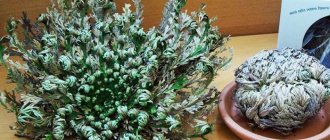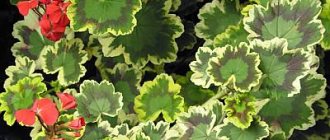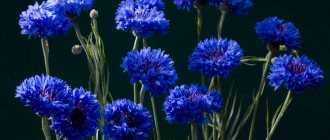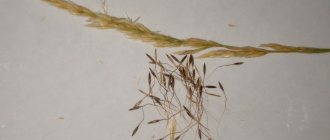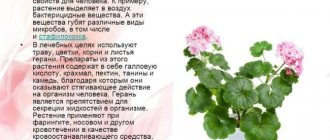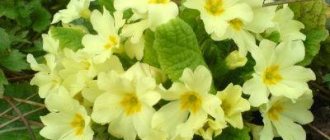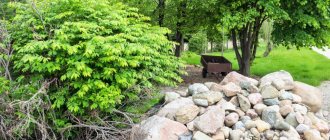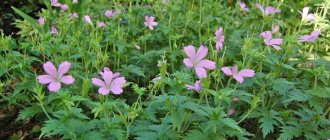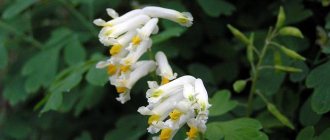Large-rhizome (Balkan) geranium spread throughout Europe from the Balkans, Alps, and Carpathians. In Bulgaria they call her “zdravets”. The plant has a musky aroma, which is characterized in different ways.
Author of the article
Eleonora Borisova
Specialist in medicinal plants and their use in folk medicine.
Perfumers say that it resembles the smell of tobacco, clary sage, fruity wood, and tea leaves. Large-rhizome geranium is planted in flower beds, under trees, and used as lawn grass.
This plant is considered medicinal; the leaves and roots are used in the treatment of heart disease and nervous disorders.
Description
The height of garden large-rhizome geranium does not exceed 40-45 cm, the roots are not deep, the stem is branched. Rounded leaves on long cuttings with fluff, as if cut into 5-7 parts. The lower ones are sessile and consist of three lobes. In temperate climates they turn yellow or red in autumn, but remain green in the south.
A similar plant, Yucca domestica
On stalks there are two flowers of pink, red, violet-pink shades. Flowering begins in June and lasts about a month. The fruits are capsule-shaped; the seeds ripen in late summer.
Himalayan geranium (Geranium himalayense)
In nature, the plant is found in the foothills of the Himalayas. This meadow crop found application in cultural plantings back in the second half of the 19th century.
Himalayan geranium forms a dense herbaceous bush with a height of 30 to 60 cm. This species has large five-fingered leaves with a diameter of about 10 centimeters. The petioles and leaf blades are heavily pubescent. The flowers, compared to other varieties of garden geraniums, are quite large. The corollas, located in pairs on peduncles, reach a size of 4 centimeters. This feature determined the second name of the garden geranium species - large-flowered.
The color of the flowers is predominantly bluish or purple. Against this background, contrasting purple veins are clearly visible. Flowering begins in the second half of May and lasts all summer.
Today, numerous cultivated varieties of Himalayan geranium have been obtained; there are also compact dwarf forms, not exceeding 30 cm in height.
Particularly famous is the variety of Himalayan geranium Plenum with double delicate flowers. The duration and intensity of flowering can be maintained by regularly cutting off spent inflorescences.
Varieties
The best varieties for the garden.
Ingwersen's Variety
The leaves are light, the flowers are pink;
Bevan's Variety
The flowers are bright, purple, red;
Czacor
Compact, veinless petals, purple-tinged foliage in autumn;
Variegatum
The leaves are gray-green, the flowers are purple-pink;
Album
Among the white petals are pink stamens;
White-Ness
The flowers are white;
Grandiflorum
Very large flowers;
Pindus
The flowers are red, bright;
Spessart
The flowers are white, the petals seem to be superimposed on one another.
Geranium is planted with irises, bells, and speedwells.
Characteristics and benefits of the plant
Garden geranium or cranberry belongs to the Geraniaceae family. It grows throughout the world in the form of shrubs and herbs. There are about 400 varieties in total. The abundance of varieties will please even experienced gardeners; in addition to simple inflorescences, there are complex hybrids with double flowers and exotic colors that cannot be found on meadow geraniums.
The leaves are petiolate, have 3–5 leaves, and most species are soft-haired. Peduncles with one or three flowers. The inflorescences are bright, large, and come in white, purple, pink and violet of all shades. The fruit is in the form of a capsule with retained sepals. When ripe, the fruits open and the seeds are scattered far from the place of growth. In spring, seedlings can be found on the other side of the site.
If you don’t know which flower to choose for planting, we recommend taking a closer look at geraniums. Pros of the plant:
- The flower is one of the few that adapts perfectly and can tolerate minor weather fluctuations.
- Suitable for open soil.
- Miniature planting material easily fits into small and even cramped pots.
Growing
Agricultural technology
Planting and caring for large-rhizome geraniums does not require much time and effort. For propagation, you can use rhizomes and stems. It is enough to plant them in a pot or soil and water them. They take root quickly, without additional care.
Although this plant can grow in almost any place (in the sun, under trees, in garden inconveniences, among stones), compliance with some rules is still required:
- the place is selected based on the characteristics of the variety;
- the soil should be of average fertility and good drainage;
- the distance between plants is 25-30 cm, among the rows - approximately 0.7-1 m;
- watering with a large volume of water, but not often;
- loosening the soil, weeding, mulching is required;
- timely removal of faded flowers;
- pruning to prolong flowering.
For planting, a standard scheme is used: holes are dug, drainage is poured onto the bottom, the roots of the plant are straightened and covered with soil. It is important to accurately dose water for irrigation. Geranium tolerates drought much better than excess moisture. This plant does not require feeding. Most varieties shelter for the winter.
Ease of propagation allows you to grow a large amount of planting material in a short time.
You can read about other perennial medicinal herbs in the “Medicinal Herbs” section.
Plant care
Watering is carried out in the morning or evening with settled water. Immediately after transplantation and in the first months, it is recommended to water abundantly. Consider what kind of soil you have on your site. If the soil is wet, reduce the amount of watering. On particularly dry days, moisturize several times a week or every other day. There is no need for spraying. If the leaves of the plant are drooping, the geranium is hot and lacks moisture. In this case, shade the flower and water it.
There is no special need to feed fertilizers. The plant needs compost and peat added during planting. The only thing is that it can be fertilized during active growth with mineral fertilizers.
What to do if the plant does not bloom?
Each variety is characterized by the appearance of inflorescences at a certain time. Study the information about when flowering should begin for your particular variety. It may be absent due to non-compliance with care rules. When the plant begins to shed its leaves, it may indicate the beginning of a dormant period. At this time, it is important to reduce watering to once a week and a little less often, and completely remove fertilizing. The flower can be moved to a dark and cool place.
It is better to remove them from the dormant period no earlier than February and do it gradually. To do this, place the plant in its usual, sunny place, and gradually return watering. After the first leaves appear, care continues as for an ordinary flower. You can place the plant closer to the sun for several hours a day. By the beginning of flowering, fertilizing is required.
When growing, take into account all phases of development. Only in this case will the plant produce abundant flowering after purchase and transplantation to a new location.
Geranium pruning
Regular pruning is needed to remove long stems, form a proper crown, and remove yellowed leaves. If there are shoots on the plant that do not bear fruit, they take some of the nutrients themselves. Due to the provision of such shoots, flowering may be sparse. Regular pruning encourages the growth of new stems, leaves and buds. If the geranium is evergreen, then it can be left for the winter without pruning.
The procedure should be carried out in the autumn. Get rid of shoots that originate in the leaf axils. If this happens, then re-pruning of garden geraniums is carried out in February, before the growing season. Save branches that have a few green leaves.
Transplantation and propagation
Garden geranium is considered an unpretentious plant; it can bloom in one place for 10 years. It is not worth replanting unnecessarily, since the plant does not respond well to interventions. If you notice that roots have begun to stick out through the drain hole in the pot, then the flower needs to be replanted.
A suitable time is the growing season, which occurs in spring. There is no need to select a pot for growth. If you plan to plant flower beds, the container may be 1 cm larger than the previous pot. A wide pot provokes branching, and in this case flowering will be poor.
A common method of propagation is by seeds. Planting material purchased at a flower shop gives excellent germination results. Before planting, prepare the soil. To prevent seedlings from being exposed to pests and diseases, it is disinfected with a solution of potassium permanganate.
After the first shoots appear, the glass can be removed and the boxes can be placed in a bright place at a temperature of 16–20 degrees. 1.5-2 months after picking, each plant will have 2-3 true leaves. Adult specimens are planted in separate pots. When a few more leaves appear on the geranium, you can pinch off the young shoot. After planting in flower beds, the bush will branch and produce abundant flowering.
Can also be propagated by cuttings. To do this, it is enough to separate the necessary shoots. It is recommended to carry out separation during the growing season - in the spring. A suitable cutting is a shoot 5–7 cm long with several green leaves. After cutting the cutting, it should be dried. To do this, leave the shoot on the windowsill. Treat the cut with crushed coal. You can plant it directly into a pot. The soil for planting must be nutritious.
If you choose sand, make sure it is always wet. In this case, water should not get on the cuttings. Rooting occurs at a temperature of 20–23 degrees. When developed and good roots appear, the shoot is transplanted to a new place in a separate pot; care will be the same as for an adult plant.
Use of strong rhizomatous geranium
Large rhizomatous geranium is used:
- to create a pattern in flower beds from groups of flowers of different colors;
- as a background, framing element;
- for filling voids in flower beds, between decorative bushes;
- in rockeries, rock gardens, alpine slides;
- for decorating decorative masonry;
- to strengthen slopes;
- for establishing a lawn (as in the photo of large-rhizome geranium);
- if necessary, plant landscaping in hard-to-reach places (in one of the parks in Hamburg, free spaces under benches were planted with these plants);
- to create borders that zone space.
On the lawn, it is important that all varieties reproduce abundantly by self-sowing. If you buy a winter-hardy species, the plants will shed their leaves in the fall and overwinter without shelter.
Propagation of garden geraniums
This unpretentious plant can be propagated in various ways - from sowing seeds to cuttings.
Propagation by seeds
The seed method involves sowing seedlings. This method guarantees a higher percentage of seedlings. For sowing, prepare a container with drainage and soil. At the end of April the seeds are sown. You can use plastic cups for this, from which it is later easier to remove the plant with a lump of earth and replant it in open ground.
After sowing the seeds and watering, the containers are covered with polyethylene and placed on the windowsill. The appearance of seedlings is a signal that the plantings should begin to be ventilated.
Diving begins after the appearance of the 3rd leaf. Seedlings are planted in open ground after warm weather has established at least +18C. If necessary, seedlings are covered at night.
Protection from pests and diseases
Perennial geraniums rarely get sick. But sometimes it suffers from bacterial rot and tomato wilt. Brown spots appear on the plant and it gradually fades. If the damage is insignificant, you can treat the geranium with copper-containing preparations. If the disease has damaged most of the bush, it is better to completely dig it up and destroy it.
Geranium pests:
- aphid;
- whitefly
If insect colonies have not yet grown significantly, you can treat the infected plants with a soap solution. But insecticides (Aktara, Decis and others) cope more effectively with pests.
